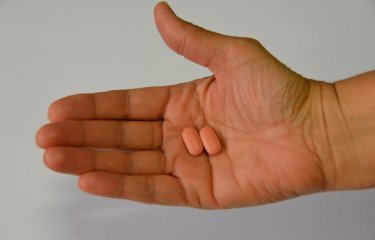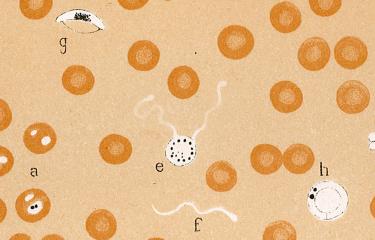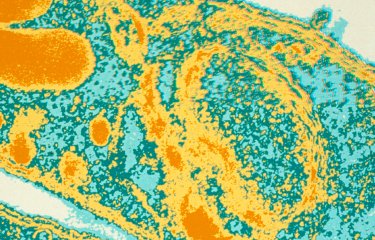Scientists at the Institut Pasteur in Paris, the Institut Pasteur in Cambodia, the French National Center for Scientific Research (CNRS), and the U.S. National Institutes of Health (NIAID/NIH) have identified a molecular marker for detecting malaria parasites with resistance to artemisinin derivatives (major components in antimalarial medicine or drug treatments currently recommended by the World Health Organization, WHO). The discovery of this marker will increasing our understanding of parasite resistance to artemisinin derivatives, improved monitoring of the spread of resistant forms of malaria, and the swift adaptation of effective treatment methods to combat this disease. This research was published online December 18, 2013 by the journal Nature.
Press release
Paris, December 19, 2013

Molecular marker discovered for detecting artemisinin-resistant forms of malaria
Scientists at the Institut Pasteur in Paris, the Institut Pasteur in Cambodia, the French National Center for Scientific Research (CNRS), and the U.S. National Institutes of Health (NIAID/NIH) have identified a molecular marker for detecting malaria parasites with resistance to artemisinin derivatives (major components in antimalarial medicine or drug treatments currently recommended by the World Health Organization, WHO). The discovery of this marker will increasing our understanding of parasite resistance to artemisinin derivatives, improved monitoring of the spread of resistant forms of malaria, and the swift adaptation of effective treatment methods to combat this disease. This research was published online December 18, 2013 by the journal Nature.
While almost 40% of the world’s population is exposed to malaria, no vaccine currently exists. Each year this disease, triggered by parasites of the Plasmodium genus, affects several hundred million people and is the cause of nearly 660,000 deaths. Over the past ten years, the emergence in western Cambodia of parasites resistant to the artemisinin derivatives used in the latest antimalarial treatment combinations has threatened to compromise efforts to effectively eradicate the disease.
One of major concern is that drug resistant parasites will spread to sub-Saharan Africa, the region most affected by malaria, as has occurred in the past with chloroquine-based treatments or those using antifolic and antifolinic agents.
Until now, monitoring the spread of resistant forms of malaria has been limited to clinical trials which are difficult and costly to implement. In this context, a close collaboration between teams led by Frédéric Ariey and Odile Puijalon at the Institut Pasteur (Paris), Didier Ménard at the Institut Pasteur in Cambodia (Phnom Penh), Françoise Benoit-Vical at the CNRS (Toulouse), and Rick Fairhurst at the NIAID/NIH (Bethesda, Maryland, USA) as well as Cambodian partners at the Centre National de Malariologie (National Center for Malariology) have produced research results that will take the fight against malaria to a whole new level.
Together the scientists have solved a conundrum that has been frustrating the scientific community for several years - the identification of a molecular marker closely linked to artemisinin resistance in Plasmodium falciparum. This molecular marker represents a powerful tool for detecting resistant forms of malaria, making it possible to map out their worldwide distribution, and swiftly adapt treatment methods to combat this life-threatening disease.
The identification of this marker has been possible thanks to an original approach developed by this international group of scientists, that combines genomics, biology, clinical studies and epidemiology. By sequencing the genome of a strain of Plasmodium falciparum, made resistant in the laboratory, and comparing it with an identical, non-resistant strain, the scientists discovered a mutation in a specific gene which enabled the laboratory strain of malaria to resist high doses of artemisinin. The polymorphism of the gene was then studied in the resistant strains of malaria circulating in Cambodia, enabling the scientists to establish a strong correlation between the presence of the mutant gene and resistance observed both in the lab cultures and in the malaria patients treated in Cambodia.
With this markers identified, an analysis of several strains of malaria collected in Cambodia over the past decade has now confirmed a gradual increase in the frequency of mutant parasites in provinces affected by malaria resistance.
This then led the teams of scientists to ascertain that mutations affecting this gene constitute a reliable molecular signature for artemisinin derivative resistance.
The discovery made by scientists at the Institut Pasteur in Paris, the Institut Pasteur in Cambodia, the CNRS and the NIAID/NIH represents a major advance in the fight against malaria and a significant step toward the eventual eradication of this disease.
--------------------------------------------------------------------------------------------------
This research received support from:
- Institut Pasteur: Natixis, IBEID LabEx (Laboratories of Excellence) project, French National Research Agency, Rotary Club-Versailles
- Institut Pasteur in Cambodia: Institut Pasteur International Division, Natixis, Global Fund Grant Malaria Program Round 6 and Round 9, World Health Organization
- CNRS
- Inserm
- NIH, Intramural Research Program, NIAID: U.S. DOD Global Epidemic Information System, Intramural Research Program, NIAID, NIH
Source
"A molecular marker of artemisinin-resistant Plasmodium falciparum malaria", Nature, December 18, 2013.
Frédéric Ariey (1,2,3), Benoit Witkowski (4), Chanaki Amaratunga (5), Johann Beghain (1,3,6), Anne-Claire Langlois (1,3), Nimol Khim (4), Saorin Kim (4), Valentine Duru (4), Christiane Bouchier (7), Laurence Ma (7), Pharath Lim (4,5,8), Rithea Leang (8), Socheat Duong (8), Sokunthea Sreng (8), Seila Suon (8), Char Meng Chuor (8), Denis Mey Bout (9), Sandie Ménard (10), William O. Rogers (11), Blaise Genton (12), Thierry Fandeur (1,4), Olivo Miotto (13,14,15), Pascal Ringwald (16), Jacques Le Bras (17), Antoine Berry (10), Jean-Christophe Barale (1,3), Rick M Fairhurst (5), Françoise Benoit-Vical (18,19), Odile Mercereau-Puijalon (1,3), Didier Ménard (4).
(1) Institut Pasteur, Parasite Molecular Immunology Unit, Paris, France
(2) Institut Pasteur, Genetics and Genomics of Insect Vectors Unit, Paris, France
(3) French National Center for Scientific Research (CNRS), Associated Research Unit 2581, Paris, France
(4) Institut Pasteur in Cambodia, Malaria Molecular Epidemiology Unit, Phnom Penh, Cambodia
(5) Laboratory of Malaria and Vector Research, National Institute of Allergy and Infectious Diseases, National Institutes of Health, Bethesda, MD, USA
(6) Institut Pasteur, Functional Genetics of Infectious Diseases Unit, Paris, France
(7) Institut Pasteur, Genomics Platform, Genomes and Genetics Department, Paris, France
(8) National Center for Parasitology, Entomology and Malaria Control, Phnom Penh, Cambodia
(9) SSA WHO, Drug Monitoring in Cambodia, National Center for Parasitology, Entomology and Malaria Control, Phnom Penh, Cambodia
(10) Toulouse-Purpan Pathophysiology Center, INSERM UMR1043 - CNRS UMR5282 – University of Toulouse III, and Parasitology and Mycology Department, Toulouse University Teaching Hospital, Toulouse, France
(11) Naval Medical Research Unit #2 Detachment, Phnom Penh, Cambodia
(12) Infectious Disease Service & Department of Ambulatory Care and Community Medicine, University of Lausanne, and Swiss Tropical and Public Health Institute, Basel, Switzerland
(13) MRC Centre for Genomics and Global Health, University of Oxford, Oxford OX3 7BN, UK
(14) Mahidol-Oxford Tropical Medicine Research Unit, Mahidol University, Bangkok 10400, Thailand
(15) Wellcome Trust Sanger Institute, Hinxton, Cambridge CB10 1SA, UK
(16) Global Malaria Program, World Health Organization, Geneva, Switzerland
(17) French National Reference Center for Malaria, Bichat-Claude Bernard Teaching Hospital, Paris Public Hospital Network (APHP), Research and Higher Education Cluster (PRES) Sorbonne Paris Cité, Faculty of Pharmacy, and Mother and Child Faced with Tropical Infections, IRD joint research unit 216, Paris, France
(18) French National Center for Scientific Research, Coordination Chemistry Laboratory UPR8241, Toulouse, France
(19) University of Toulouse, Paul Sabatier University, INPT, Toulouse, France
Contact
Institut Pasteur Press Office
Jérémy Lescène - +33 (0)1 45 68 81 01
Nadine Peyrolo – +33 (0)1 45 68 89 28
presse@pasteur.fr





